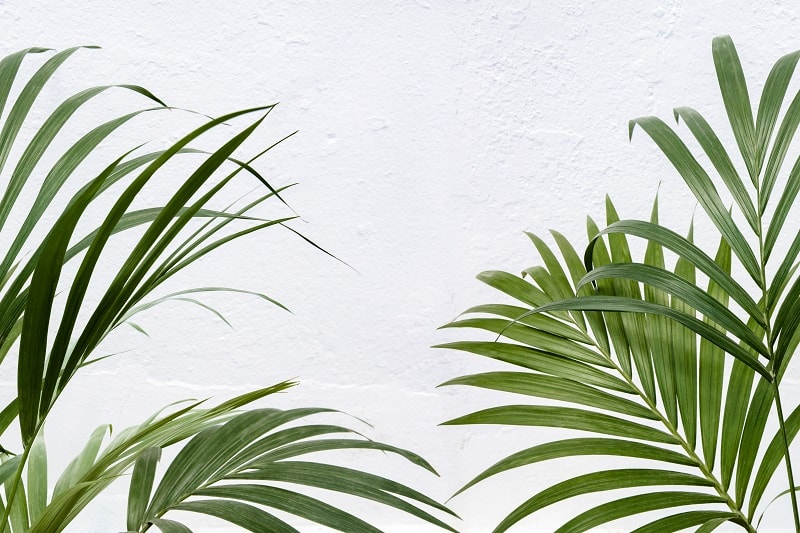
Kentia palms are also known as paradise or sentry palms, and have typical, large, palm-shaped leaves. Their botanical name is Howea forsteriana, and they can grow up to 12 feet tall. These tropical plants are native to the South Pacific and Lord Howe Island, Australia, and thrive in sandy, well-drained soil. They are popular indoor plants, but can also be prone to diseases and conditions that cause their leaves to turn yellow.
Kentia palm leaves turning yellow: Common reasons
It could be due to overwatering.
Kentia palms are prone to yellowing leaves due to stagnant moisture in the soil because of overwatering. Check the soil and see to it that it is dry before watering again, usually after a few weeks. If the yellowing continues, root rot may already set in. Trim the dark and damaged roots and change the soil to a well-draining one.
Kentia palms placed indoors and in areas with cooler climates do not need very much water, but the soil should be kept moist. If you are unsure of whether or not you are watering correctly, do the finger test: Simply push one of your fingers into the soil, up to at least one inch. If the soil is dry it means you are underwatering the plant, but if it is soggy, the plant is overwatered.
It could be due to insufficient moisture or underwatering.
Kentia palm leaves could also turn yellow due to lack of moisture or underwatering. These plants prefer a humid environment, so be sure to mist them and provide water when the top two inches of soil are dry.
It could be due to too much fertilizer.
Too much fertilization could cause discoloration and may burn the leaves. These plants do not require much fertilizer, since they are slow growers. Fertilizer only in the growing seasons of spring and summer, ideally just once a month.
It could be due to too much light exposure.
Kentia palm leaves may turn yellow due to too much sunlight. These plants are prone to sunburn, so be sure not to expose them to direct sunlight. Opt for medium, indirect, or soft dappled light. Provide shade for the plants during the hottest time of the day.
If you plan to move your plants to a brighter spot, do so gradually over a couple of weeks to avoid stress. This will also reduce sunburn on the leaves. You may also use a light meter to determine the optimum amount of light for your palms.
It could be due to poor drainage.
As in the case of overwatering, if excess water becomes stagnant in the soil due to poor drainage, your Kentia palm’s leaves could turn yellow. See to it that planters and pots have drainage holes at the bottom, so that excess water does not waterlog the soil. Increase the soil’s drainage by mixing in some perlite and small pebbles, and opt for terracotta pots instead of plastic ones.
It could be due to a nutrient imbalance.
Kentia palm leaves may also turn yellow due to a nutrient imbalance or deficiency. The yellowing could signify a lack of magnesium, manganese, iron or potassium. To fix this, repot the plants using a high-quality potting mix and use well-balanced fertilizers to ensure that the plants are receiving the correct nutrients.
It could be due to the natural growth and aging process of the plants.
The leaves on your Kentia palms may be turning yellow simply because the plants are getting older. If you notice that the discoloration is toward the bottom of the leaves and among older fronds, it may be nothing to worry about. This could be just part of the plant’s natural aging process. If the young leaves are turning yellow, however, it should serve as a warning as this may be due to a nutrient deficiency.
Kentia palm care
Kentia palms prefer bright but indirect light, but a few hours of direct morning or afternoon sunlight are acceptable. Before you water the plants, make sure that the top couple of inches of the soil are dry. Maintain household temperatures at around 60 to 75 degrees Fahrenheit and avoid exposing the plants to outdoor air, especially if there are cold gusts of wind.
These plants prefer high humidity levels, so make sure you mist them regularly. They are ideal for kitchens and bathrooms if kept indoors. Interestingly, these plants can improve the air quality by filtering toxins from the environment.
Conclusion
Kentia palms are popular indoor plants and excellent air purifiers. However, they are also prone to conditions that cause yellowing leaves. These may include nutrient imbalance, poor drainage, overwatering, over-fertilizing or too much light exposure.
Image: istockphoto.com / Carther